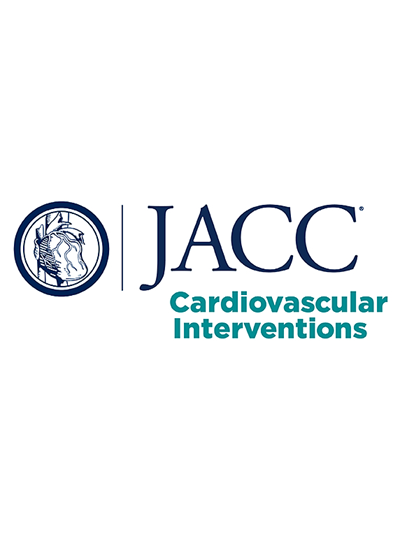用FFR/iFR不一致血管的拉回压梯度指数评估生理疾病模式
IF 11.7
1区 医学
Q1 CARDIAC & CARDIOVASCULAR SYSTEMS
引用次数: 0
摘要
背景:在大约20%的病例中,分数血流储备(FFR)和瞬时无波比(iFR)不一致,目前尚不清楚这是否受到冠状动脉疾病(CAD)生理模式的影响。抽回压力梯度指数(PPGi)可以客观表征心血管疾病的生理模式。目的:本研究的目的是评估PPGi在不一致组(FFR+/iFR- vs FFR-/iFR+)中是否存在差异。方法:本研究纳入355例慢性冠状动脉综合征患者(390支血管),经有创冠状动脉造影目视评估有≥1个心外膜冠状动脉病变,直径狭窄40% ~ 90%,定量血流比可分析FFR、iFR和PPGi。血流动力学意义的临界值为FFR≤0.80,iFR≤0.89。船只被列为FFR + / iFR + (n = 103 [26.4%]), FFR - / iFR + (n = 27 [6.9%]), FFR + / iFR - (n = 38[9.7%]),和FFR / iFR - (n = 222[57%])组。结果:中位FFR、iFR和定量流量比分别为0.84 (Q1-Q3: 0.77-0.90)、0.92 (Q1-Q3: 0.88-0.97)和0.83 (Q1-Q3: 0.73-0.90)。16.7%的病例(390例中的65例)FFR与iFR不一致。中位PPGi为0.75 (Q1-Q3: 0.67-0.85)。根据PPGi将CAD的生理模式分为390支血管中有209支(53.6%)的生理局灶性(PPGi≥0.75)和弥漫性(PPGi)。结论:CAD的生理模式是FFR/iFR不一致的重要影响因素。血管iFR的影像学验证与评价[REVEAL iFR];NCT03857503)。本文章由计算机程序翻译,如有差异,请以英文原文为准。
Physiological Disease Pattern as Assessed by Pull Back Pressure Gradient Index in Vessels With FFR/iFR Discordance
Background
Fractional flow reserve (FFR) and instantaneous wave-free ratio (iFR) are discordant in approximately 20% of cases, and it is unclear whether this is influenced by the physiological pattern of coronary artery disease (CAD). The pull back pressure gradient index (PPGi) can objectively characterize the physiological pattern of CADs.
Objectives
The aim of this study was to evaluate whether PPGi differed in discordant groups (FFR+/iFR− vs FFR−/iFR+).
Methods
The study enrolled 355 patients (390 vessels) with chronic coronary syndrome who had ≥1 epicardial coronary artery lesion with 40% to 90% diameter stenosis by visual assessment on invasive coronary angiography and had analyzable FFR, iFR, and PPGi derived from quantitative flow ratio. Cutoffs for hemodynamic significance were FFR ≤0.80 and iFR ≤0.89. Vessels were classified as FFR+/iFR+ (n = 103 [26.4%]), FFR−/iFR+ (n = 27 [6.9%]), FFR+/iFR− (n = 38 [9.7%]), and FFR−/iFR− (n = 222 [57%]) groups.
Results
Median FFR, iFR, and quantitative flow ratio were 0.84 (Q1-Q3: 0.77-0.90), 0.92 (Q1-Q3: 0.88-0.97), and 0.83 (Q1-Q3: 0.73-0.90), respectively. FFR disagreed with iFR in 16.7% of cases (65 of 390). The median PPGi was 0.75 (Q1-Q3: 0.67-0.85). The physiological pattern of CAD was classified according to the PPGi as predominantly physiologically focal (PPGi ≥0.75) in 209 of 390 vessels (53.6%) or diffuse (PPGi < 0.75) in 181 of 390 vessels (46.4%). The median PPGi was significantly lower in FFR−/iFR+ vs FFR+/iFR− vessels (0.65 [Q1-Q3: 0.60-0.69] vs 0.82 [Q1-Q3: 0.75-0.85]; P < 0.001). Predominantly physiologically focal disease was significantly associated with FFR+/iFR− (76.3% [29 of 38]), while predominantly physiologically diffuse disease was significantly associated with FFR−/iFR+ (96.3% [26 of 27] [P < 0.001] for pattern of CAD between FFR+/iFR− and FFR−/iFR+ groups).
Conclusions
The physiological pattern of CAD is an important influencing factor in FFR/iFR discordance. (Radiographic Imaging Validation and Evaluation for Angio iFR [REVEAL iFR]; NCT03857503)
求助全文
通过发布文献求助,成功后即可免费获取论文全文。
去求助
来源期刊

JACC. Cardiovascular interventions
CARDIAC & CARDIOVASCULAR SYSTEMS-
CiteScore
11.60
自引率
8.80%
发文量
756
审稿时长
4-8 weeks
期刊介绍:
JACC: Cardiovascular Interventions is a specialist journal launched by the Journal of the American College of Cardiology (JACC). It covers the entire field of interventional cardiovascular medicine, including cardiac, peripheral, and cerebrovascular interventions. The journal publishes studies that will impact the practice of interventional cardiovascular medicine, including clinical trials, experimental studies, and in-depth discussions by respected experts. To enhance visual understanding, the journal is published both in print and electronically, utilizing the latest technologies.
 求助内容:
求助内容: 应助结果提醒方式:
应助结果提醒方式:


